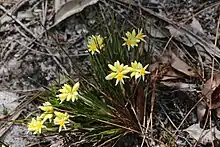| Conostylis laxiflora | |
|---|---|
 | |
| In Mount Roe National Park | |
| Scientific classification | |
| Kingdom: | Plantae |
| Clade: | Tracheophytes |
| Clade: | Angiosperms |
| Clade: | Monocots |
| Clade: | Commelinids |
| Order: | Commelinales |
| Family: | Haemodoraceae |
| Genus: | Conostylis |
| Species: | C. laxiflora |
| Binomial name | |
| Conostylis laxiflora | |
Conostylis laxiflora is a rhizomatous, tufted perennial, grass-like plant or herb in the family Haemodoraceae and is endemic to the south-west of Western Australia. It has flat, glabrous leaves, and yellow, tubular flowers.
Description
Conostylis laxiflora is a rhizomatous, tufted, perennial, grass-like plant or herb. It has flat leaves 190–600 mm (7.5–23.6 in) long, 0.7–1.0 mm (0.028–0.039 in) wide and glabrous, apart from bristles or hairs on the leaf margins. The flowers are borne in a loose cyme on a flowering stem 70–130 mm (2.8–5.1 in) long with a bract 7–30 mm (0.28–1.18 in) long subtending several flowers, each flower 13–15 mm (0.51–0.59 in) long on a pedicel 8–10 mm (0.31–0.39 in) long with floral bracts 8–13 mm (0.31–0.51 in) long at the base. The perianth is yellow, with six tepals 7–10 mm (0.28–0.39 in) long, the anthers 4.2–4.5 mm (0.17–0.18 in) long and the style 7.0–7.5 mm (0.28–0.30 in) long. Flowering occurs in October and November.[2][3]
Taxonomy and naming
Conostylis laxiflora was first formally described in 1873 by George Bentham in his Flora Australiensis from specimens collected by Augustus Oldfield near the Vasse River.[4] The specific epithet (laxiflora) means "open-flowered".[5]
Distribution and habitat
This conostylis grows in sandy soils near swamps and creeks forest and heath in the Jarrah Forest, Swan Coastal Plain and Warren bioregions of south-western Western Australia.[2][3]
References
- ↑ "Conostylis laxiflora". Australian Plant Census. Retrieved 11 December 2021.
- 1 2 "Conostylis laxiflora". FloraBase. Western Australian Government Department of Biodiversity, Conservation and Attractions.
- 1 2 Hopper, S.D; Purdie, R.W; George, A.S; Patrick, S.J. "Conostylis hiemalis" (PDF). Australian Biological Resources Study, Department of Agriculture, Water and the Environment. pp. 83–84. Retrieved 11 December 2023.
- ↑ "Conostylis laxiflora Hopper". APNI. Retrieved 11 December 2023.
- ↑ Sharr, Francis Aubi; George, Alex (2019). Western Australian Plant Names and Their Meanings (3rd ed.). Kardinya, WA: Four Gables Press. p. 236. ISBN 9780958034180.